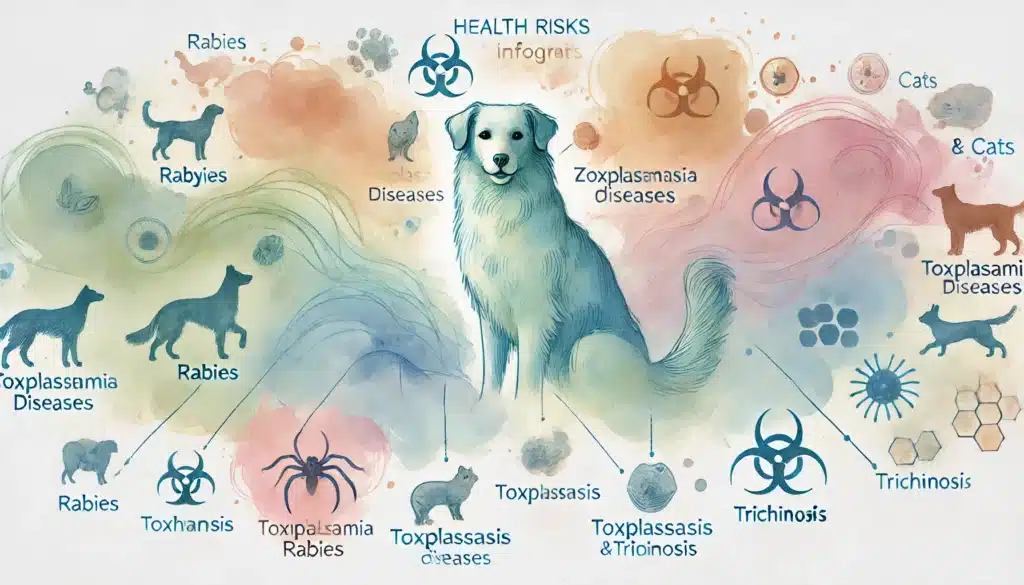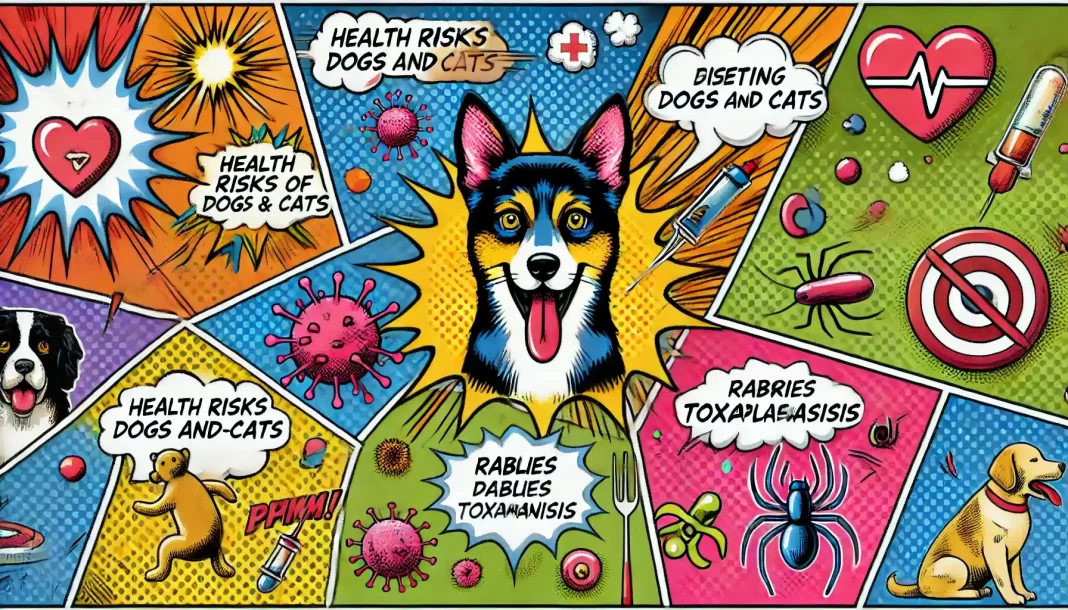Eating dogs and cats is a deeply controversial practice that poses significant medical, ethical, and psychological risks. While it remains a cultural norm in some regions, the health dangers and ethical issues associated with this practice have drawn increased scrutiny globally. This article will explore the health risks posed by consuming dog and cat meat, delve into the ethical and psychological consequences, and provide a detailed analysis of the recent claims made by political figures about immigrants consuming pets. Finally, we will discuss the broader implications of these practices, particularly as they intersect with issues of misinformation and xenophobia.
Health Risks of Eating Dogs and Cats
1. Zoonotic Diseases
One of the most significant dangers of eating dog and cat meat is the risk of contracting zoonotic diseases—those that can be transmitted from animals to humans. Zoonoses can cause severe illness, and in some cases, can be fatal.
- Rabies: Dogs are known carriers of rabies, a viral infection that affects the central nervous system and is almost universally fatal once symptoms manifest. While rabies is most often transmitted through bites or scratches, it is possible for humans to contract the virus by consuming the meat of an infected animal. The consumption of infected dog meat poses a real danger, particularly in areas where rabies remains endemic, and proper veterinary controls are lacking .
- Toxoplasmosis: Cats are primary hosts for the Toxoplasma gondii parasite, which can cause toxoplasmosis in humans. This parasite can be transmitted through the consumption of raw or undercooked cat meat. Toxoplasmosis is especially dangerous for pregnant women and individuals with weakened immune systems. In pregnant women, it can lead to miscarriages, stillbirths, or severe birth defects. In immunocompromised individuals, it can cause neurological issues, such as seizures or encephalitis .
- Trichinosis: Another serious risk comes from trichinosis, an infection caused by the Trichinella parasite, which can be transmitted through the consumption of raw or undercooked meat from infected animals. While typically associated with pork, trichinosis can also be contracted from consuming improperly cooked dog or cat meat. Symptoms include muscle pain, fever, and gastrointestinal distress, but in severe cases, it can lead to heart or respiratory problems.
2. Food Safety and Sanitation Concerns
In many parts of the world where dog and cat meat is consumed, the animals are often raised and slaughtered outside of regulated food systems. This lack of regulation creates serious food safety concerns that increase the risk of contamination and illness.
- Unsanitary Slaughter Practices: Unlike animals that are raised for food in regulated industries, dogs and cats are often killed in unsanitary conditions. This can lead to contamination by dangerous bacteria such as Salmonella, E. coli, and Campylobacter. The improper handling and processing of these animals increase the risk of foodborne illnesses, which can range from mild gastrointestinal symptoms to severe dehydration, organ failure, or death .
- Inconsistent Veterinary Oversight: In areas where dog and cat meat is eaten, veterinary oversight is often inconsistent or non-existent. The animals used for meat are frequently strays or pets of unknown origin, meaning they may carry unknown diseases or parasites. The absence of regular health checks and proper vaccinations adds to the already high health risks posed by consuming these animals .
3. Uncertain Nutritional Benefits
Although dog and cat meat may provide some protein, there is limited research regarding its nutritional value compared to more commonly consumed meats like chicken, beef, or pork. Dog and cat meat does not offer any clear nutritional advantages, and the risk of zoonotic disease far outweighs any potential health benefits.
Many health organizations and cultural leaders advocate for the consumption of safer, more reliable sources of protein that are produced under regulated food safety standards. The widespread availability of healthier meat options diminishes the need for dog or cat meat, especially given the significant health risks associated with these animals.

Psychological and Ethical Considerations
The ethical and psychological dimensions of eating dogs and cats are equally significant. In many societies, dogs and cats are valued as companions and family members, making their consumption morally and emotionally challenging for those raised in cultures where these animals are loved, rather than consumed.
1. Ethical Dilemmas and Cognitive Dissonance
In regions where dogs and cats are viewed as pets, eating these animals can cause cognitive dissonance – a psychological state where a person’s actions conflict with their values or beliefs. For individuals who grow up seeing dogs and cats as loyal companions, eating their meat can lead to intense feelings of guilt or shame. This inner conflict is especially pronounced for people who must reconcile their cultural heritage with the societal norms of their new environment. The ethical dilemma of eating an animal that one may have once seen as a friend or protector can cause psychological distress.
2. Social Stigma and Mental Health
In societies where eating dogs and cats is taboo, individuals who engage in the practice may face social stigma. This stigma can lead to ostracism, which in turn may cause feelings of isolation, anxiety, or depression. The social rejection that accompanies such practices can damage a person’s mental health, especially if they are already vulnerable due to cultural or emotional conflicts.
For immigrants or individuals transitioning to new cultures, the pressure to conform to societal expectations while maintaining personal or cultural traditions can be overwhelming. The fear of being judged or ridiculed for following traditional dietary customs may contribute to identity confusion, low self-esteem, and even psychological trauma.
3. Cultural Conflicts
For people who come from regions where eating dogs and cats is normalized, moving to cultures where these animals are revered as pets can be deeply unsettling. Immigrants who find themselves in such situations may experience heightened stress as they navigate the differences between their own cultural practices and the values of their new environment. This conflict between cultural identity and societal norms can lead to emotional and psychological strain, especially when combined with external pressures to conform.
Broader Public Health and Animal Welfare Concerns
The consumption of dogs and cats also raises broader public health and animal welfare concerns. Many animal rights organizations, such as Humane Society International, have campaigned vigorously against the dog and cat meat trade, citing the inhumane conditions in which these animals are often kept and slaughtered . In many cases, animals are subjected to extreme cruelty before being killed for food. These practices not only raise ethical concerns but also pose additional health risks, as stress and poor treatment of animals can exacerbate the spread of disease.
In addition, the dog and cat meat trade can negatively impact public health. The close contact between humans and animals in unregulated meat markets increases the risk of zoonotic disease outbreaks, as seen in past pandemics originating from wet markets. Public health experts warn that such practices should be discouraged to prevent future epidemics.
Eating Dogs and Cats – Conclusion
From a medical and public health perspective, the risks associated with eating dogs and cats are substantial. Zoonotic diseases, foodborne illnesses, and poor sanitation in meat processing create dangerous conditions for anyone who consumes these animals. Furthermore, the nutritional benefits of dog and cat meat are unclear, and safer sources of protein are readily available.
Beyond the medical risks, consuming dogs and cats presents significant ethical and psychological challenges. In cultures where these animals are seen as pets, their consumption can lead to cognitive dissonance, social stigma, and emotional distress. The practice also raises broader questions about animal welfare and public health.
The Trump Claim: Misinformation and Its Consequences
During a September 10, 2024, televised debate, former President Donald Trump claimed that Haitian immigrants in Springfield, Ohio, were eating the local residents’ dogs and cats. This statement caused widespread outrage and confusion, but it was quickly debunked by local authorities. The Springfield Police Department and city officials confirmed that there were no credible reports of pets being harmed or eaten by immigrants.
Trump’s remarks were based on unverified rumors that had circulated on social media. Despite his insistence, no verifiable evidence supported his claims, which were ultimately deemed to be unfounded. The spread of such misinformation not only fosters xenophobia and fear but also reinforces harmful stereotypes about immigrants.
This incident highlights the importance of relying on credible, evidence-based information when discussing sensitive issues, particularly those that can incite panic or prejudice. Unfounded accusations, especially those targeting vulnerable communities, have the potential to cause significant harm.
Sources
- PolitiFact. “Trump Repeats Baseless Claims That Haitian Immigrants in Springfield, Ohio, Are Eating Pets.”
- Daily Dot. “Trump Claims Immigrants Are Eating Dogs in Springfield, Ohio.”
- CDC. “Rabies.”
- Mayo Clinic. “Toxoplasmosis.”
- WHO (World Health Organization). “Foodborne Diseases.”





